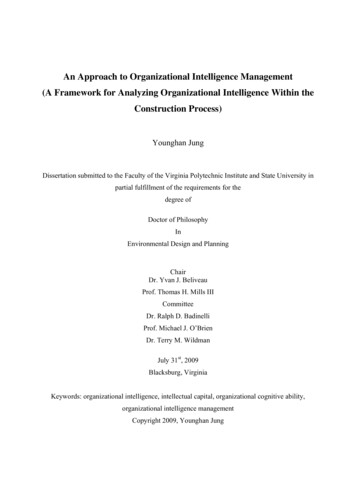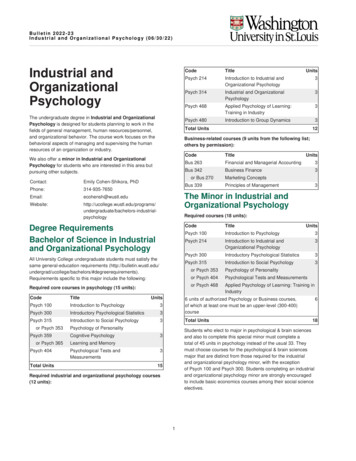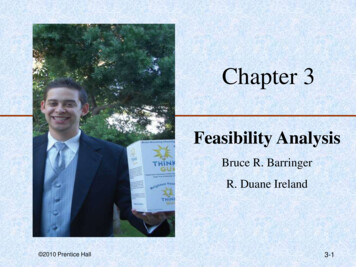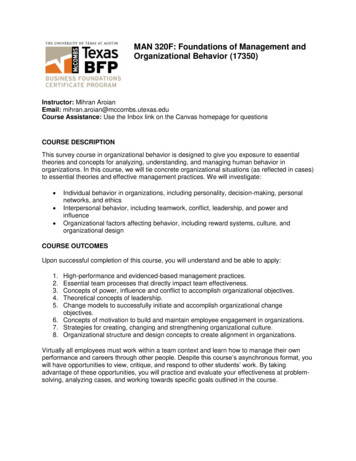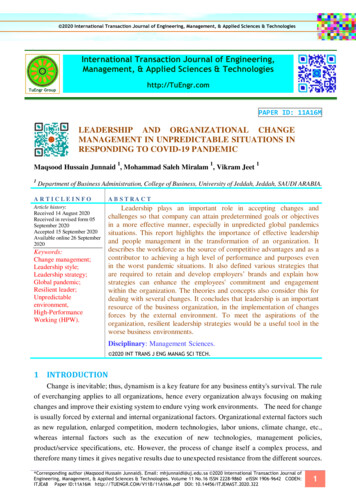
Transcription
2020 International Transaction Journal of Engineering, Management, & Applied Sciences & TechnologiesInternational Transaction Journal of Engineering,Management, & Applied Sciences & Technologieshttp://TuEngr.comPAPER ID: 11A16MLEADERSHIP AND ORGANIZATIONAL CHANGEMANAGEMENT IN UNPREDICTABLE SITUATIONS INRESPONDING TO COVID-19 PANDEMIC11Maqsood Hussain Junnaid , Mohammad Saleh Miralam , Vikram Jeet11Department of Business Administration, College of Business, University of Jeddah, Jeddah, SAUDI ARABIA.ARTICLEINFOA B S T RA C TArticle history:Received 14 August 2020Received in revised form 05September 2020Accepted 15 September 2020Available online 26 September2020Leadership plays an important role in accepting changes andchallenges so that company can attain predetermined goals or objectivesin a more effective manner, especially in unpredicted global pandemicssituations. This report highlights the importance of effective leadershipand people management in the transformation of an organization. Itdescribes the workforce as the source of competitive advantages and as acontributor to achieving a high level of performance and purposes evenin the worst pandemic situations. It also defined various strategies thatare required to retain and develop employers’ brands and explain howstrategies can enhance the employees' commitment and engagementwithin the organization. The theories and concepts also consider this fordealing with several changes. It concludes that leadership is an importantresource of the business organization, in the implementation of changesforces by the external environment. To meet the aspirations of theorganization, resilient leadership strategies would be a useful tool in theworse business environments.Keywords:Change management;Leadership style;Leadership strategy;Global pandemic;Resilient rking (HPW).Disciplinary: Management Sciences. 2020 INT TRANS J ENG MANAG SCI TECH.1 INTRODUCTIONChange is inevitable; thus, dynamism is a key feature for any business entity's survival. The ruleof everchanging applies to all organizations, hence every organization always focusing on makingchanges and improve their existing system to endure vying work environments. The need for changeis usually forced by external and internal organizational factors. Organizational external factors suchas new regulation, enlarged competition, modern technologies, labor unions, climate change, etc.,whereas internal factors such as the execution of new technologies, management policies,product/service specifications, etc. However, the process of change itself a complex process, andtherefore many times it gives negative results due to unexpected resistance from the different sources.*Corresponding author (Maqsood Hussain Junnaid). Email: mhjunnaidi@uj.edu.sa 2020 International Transaction Journal ofEngineering, Management, & Applied Sciences & Technologies. Volume 11 No.16 ISSN 2228-9860 eISSN 1906-9642 CODEN:ITJEA8 Paper ID:11A16M http://TUENGR.COM/V11B/11A16M.pdf DOI: 10.14456/ITJEMAST.2020.3221
To successfully implement change, effective leadership and management could be the major factor inthe process. At the same, it has been observed that organizational leaders had faced heightenedpressure in organizational change formulation and implementation (Pawar & Eastman, 1997). Whileconceptualizing the organizational change, it is defined as “a relevant environmental shift thatdemands intentional organizational responses to contain new procedures, rules, values, processes,and personnel belief system” (Seeger, et al., 2005 Porras & Silvers, 1991, p. 52;). With the referenceto the stated definition, an organizational change is considered as a robust area of analysis thatprimarily focused on strategic change (Kotter and Schlesinger, 1979). Organizational change hasalways been complemented by the planned strategies, aligned with the organizational goal. Thus, theimplementation of a flexible strategic change process, it helps the organizational system andmembers to upgrade and modify the existing system under the requirements of new circumstances.Such as a different way to contain new technologies, contingencies, processes, and personnel values(Kanter,1983; Mintzberg, 1984; Barczak et al., 1988).Change management is defined as the conversion of the individual, team members, andorganization from currents to specific future states so that vision and strategies can be implemented.This will define about workforce for competitive advantages. It formulates strategies for workforceretention and development as well as enhances their commitment and efficiency within theorganization. The present research study is an attempt to define the leadership approaches, theories,concepts, tools, and techniques that are interconnected with organizational changes. It expoundsintellectual capacity, leadership abilities, and managerial capabilities that are concomitant with thechange management and contribution of people to achieve goals or targeted vision of theorganization.The outcome of the organizational change process is highly influenced by leadership practices.Thus, leadership can be recognized as the art and quality of an individual to motivate and influenceemployees’ behaviors to act to attain tasks or objectives. Leadership is an ongoing practice, aimed toenergies the skills and capabilities to extract the best results from the people, through positivemotivation to achieve organizational goal. In such a way, leaders play a vital role in the organizationas the source of bringing new ideas and to create a corrective path in the organizational changeprocess. The importance of leadership highlighted by many researchers such as “Successfulleadership not only develops vision, mission, strategy, and cultural value of the organization forchange, but also empowers and motivates employees in change commitment.” (Gill, 2002).In change management, the transformational leadership style gained high attention among theresearcher and academician. Transformational leaders are recognized as charismatic, vision-oriented,confident, and trustworthy leaders, easily reap the trust and belief of employees. It has beenhighlighted in research that transformational leadership has a significant positive relationship withthe employees’ performance even in the organizational change process (Liu, 2008; Herold, et al.2008; Paulsen, et al. 2013). In comparison to transactional leadership, transformational leadershipbrought positive outcomes, especially in change management (Eisenbach, et al. 1999; Hill et al.,2012). Empirically, it evident that transformational leadership has been optimistically associated withemployees’ performance in change processes (Herold et al.,2008). The process of the organizationalchange management system requires minimal alterations in the daily activities and formalinteractions, which progressively improves the performance. in implementation of the strategicchange, it may impact the organization and its members in negative, thus it has been indorsed that the2Maqsood Hussain Junnaid, Mohammad Saleh Miralam, Vikram Jeet
stepwise change model would be beneficial at the operational level (Johnson & Scholes 1999). Todevelop effective implementation plans, Johnson & Scholes (1999), (p. 46) classified four types ofstrategic change stages such as continuity, flux, incremental, and transformational. In thecontinuation, Despite, et al. (1996, pp. 23–7) provided three categories of organizational change likedevelopmental changes, transitional changes, and transformational changes.This study analyzes the conceptual models and qualitative researches, highlighting theimportance of effective leadership and change management in the present scenario. References havebeen taken from the research article, studies, and theoretical models published in reputed journals, toprovide insights into leadership in change management, to deal with the inverse conditions ofbusiness environments. In the current business situations where organizations are encountered withthe Covid-19 pandemic, there is a need to understand the importance of leadership and changemanagement for organizational sustainability. Thus, extensive literature has been provided in thesubsequent parts of the study, which highlights and provides the guidelines to deal with the inversebusiness conditions with effective leadership and change management processes. This study researchquestions are to highlight the importance of effective leadership and change management in thetransformation of the organization, to explore strategies that are required to retain and developemployers’ brands, to highlight leadership strategies that work in uncertain businesses environmentlike Covid 19 pandemic, and to highlight suitable change management models during unprecedentedCovid 19 situations.2 LEADERSHIP AND ORGANIZATIONAL CHANGE MODELSEvery business organization has to operate in a dynamic environment that keeps on changingwith time hence, there are several concepts, tools, and theories in association with organizationalchange. In the change, process organizations must adopt these concepts into their system so that thewhole work process can be carried out effectively and efficiently (Tiwari, 2011). Some changemanagement models that can help the organization to accept changes are described below:Lewin's model of Change: Lewin's (1947) have proposed the model of change in which threesteps are formulated to accept the change can be a useful tool in global pandemic situations (Figure1). The suggested three dimensions of the model are the best fit to diagnose and implement thechange. The first step ‘unfreeze’ involves that business organization must realize the need forbringing change and hence, the current working process must be modified with several means withrelevance to the current pandemic situations. In continuation, the communication of the changeprocess has also an important impact and should be available for every organizational member (Lloydand Walker, 2011).Figure 1: Model of change (Lewin, 1947).*Corresponding author (Maqsood Hussain Junnaid). Email: mhjunnaidi@uj.edu.sa 2020 International Transaction Journal ofEngineering, Management, & Applied Sciences & Technologies. Volume 11 No.16 ISSN 2228-9860 eISSN 1906-9642 CODEN:ITJEA8 Paper ID:11A16M http://TUENGR.COM/V11B/11A16M.pdf DOI: 10.14456/ITJEMAST.2020.3223
In the second phase of the model, implementation of the change phase involves introducing therequired changes into the system so that the work process must be conducted in a new way for smoothfunctioning in the pandemic environment. The last step refreeze involves monitoring the changes thathave been implemented so that critical evaluation can be performed, and steps must be taken toremove any barrier which has been formed. Leading organizations in the pandemic can adopt thischange model so that changes can be introduced effectively and results in accomplishing the ultimateorganizational goal.Figure 2: Kotter’s (1996) Eight-step Change Model.Kotter (1996), the ‘Eight-step Change Model’ of planned change is another suitable tool forsustainable change in the pandemic work environment. The model is also based on Lewin’s changemodel, highlighting the focus on the organizational workforce at different levels of the changemanagement process. In unpredictable pandemic situations, leaders can initiate the change byacknowledging the sense of urgency, forced by the external environment. Followed by creating ateam of key team players for developing the new vision in such an environment. The coalition amongteam members shaped the organization towards successful change initiatives. Further, three steps inthe process are entitled to engaging and enabling the whole organizational members in the pandemicsituations, through the proper communication channel, empowering them for their respective tasks,and assigning them short-term objectives. Last two steps in the process responsible for anchoring thenew changes into the organizational culture and system and ensuring the benefits attained throughchange endeavor are retained for a long.3 LEADERSHIP OF MANAGING CHANGEIn the successful implementation of change, the role of leadership highly significant andforemost, supported by the corporate values and communication channel. “Leadership, in TheLeadership Trust’s view, is about showing the way: using personal power to win the hearts and mindsof people to work together towards a common goal” (Gill, 2001). The major challenges for the globalleaders in the change process are in form of creating a successful and sustainable work environmentfor sustainable organizational growth (Nixon 2002). In the continuation, the multiple dimensions oftransformational leaders help to understand the requirement of change and face the challenges ofchange emotionally and intellectually (Dubrin 2001). Whereas the leader’s most difficult task in thechange process is to aligning all organizational members to adopt the change, develop the futurevision, strategy formulation, and synergies the efforts towards the organizational goal (Hooper &4Maqsood Hussain Junnaid, Mohammad Saleh Miralam, Vikram Jeet
Potter 2000; Heifetz & Laurie, 1997).3.1 LEADERSHIP ANDADVANTAGESWORKFORCEASASOURCEOFCOMPETITIVEIn the present scenario, it is difficult to manage the workforce and develop people due to toughcompetition so this study defines that how effective a team can be formulated for achieving commontasks or objectives in a well manner (Koustelios, 2014). Leaderships play a crucial role in creatingeffective environments in the organizations by forming a skilled team, and management of people toget work done by them. In which Human resource departments function becomes more crucial torecruit or select the best candidates for their organizations, who can complete work and can performthe activities of the organization in a well manner. Contemporary management can be consideredwhile making the strategies and formulate an action plan to create a better workforce within the firm.There is a possibility of contributing more to sustainable competitive advantages within anorganization. Change management plays a crucial role in every business firm which depends onenvironmental factors that affect the firm in various ways (Berger and Berger, 2011).The human resource function is very important for every business firm that must be performed ina very effective way to be succeeded. HR managers of leading organizations always focus onimproving organizational performance and increase productivity with the help of formulatingstrategies and allocate tasks among employees as per their quality or ability so that they can focus onaccomplishing particular tasks or objectives in a good manner. Organizations’ emphasis is to developthe human resource by offering extra benefits and motivate employees by appreciating theirperformance so that they feel more valued and important person within the firm. Managers focus onconducting several programs such as training and developing and learning sessions so that betterknowledge can be given to them (Bolman, 2017). This will support enhancing worker's skills,abilities, and capabilities to perform better and attain set targets or business goals. In the competitiveand global business environment, modern business setups required an effective HR system, toperform various tasks such as select, develop and produce workforces with increasing performanceswhich will support in defining organizational positions or justify investments as well. Betterworkforces and skilled people always contribute more to the firm in increasing productivity andprofitability by performing every task in better ways.3.2 LEADERSHIP STRATEGIES FOR PEOPLE RETENTION & DEVELOPMENTIn the present era, business leaders are generally recognized as per their workforces to achievecompetitive advantages. Human resource is one the best component as well as important aspects forappropriately running an organization. This department takes responsibility to attract and retain moretalented employees within the firm therefore, effective strategies are required to create a betterorganizational workforce in an impressive way (Deal, 2017). In the modern world, a shortage of skillscan be seen because various firms are focusing on appointing skilled and experienced holder'spersons for building a good brand image and increase work productivity as well. Every business has areputation in the marketplace regarding its products or whatever it sells. They also have a reputationlike an employee, so this is defined as the employer branding which is very necessary or important forevery firm to achieve particular competitive advantages. Firms can improve their businessperformance and efficiency in the future by hiring more talented and skillful employees and also byaccepting various changes and challenges within the firm. Leaders can support improving individual's*Corresponding author (Maqsood Hussain Junnaid). Email: mhjunnaidi@uj.edu.sa 2020 International Transaction Journal ofEngineering, Management, & Applied Sciences & Technologies. Volume 11 No.16 ISSN 2228-9860 eISSN 1906-9642 CODEN:ITJEA8 Paper ID:11A16M http://TUENGR.COM/V11B/11A16M.pdf DOI: 10.14456/ITJEMAST.2020.3225
performances by providing better guidelines and conducts training and development programs toattain set targets.High Performance Working (HPW) concerns with various aspects that create a culture byconsidering transparency, open lines of the communication process, and trust within the firm. It alsodefines the traditional hierarchical structure which plays a vital role in increasing higher performanceand most HR managers must consider while formulating better strategies or plans as well. Manyorganizations used this for attracting many fresh talents, ideas, and make a skilled workforceenvironment to achieve competitive advantages efficiently. There should be an effective structure inthe organization that operates business functions, create a flatter structure for every employee so thatthey can feel happy, engaged, motivated and understand the visions or missions of the firm in a moreefficient manner. HPW plays an important role in business firms as it is defined as the generalapproach used for managing entire operations or functions to stimulate employees' involvement andcommitment to accomplish set targets or goals with a higher level of performance. High-PerformanceWorking (HPW) can be defined as the fundamental series in which included processes, practices, andpolicies that must put into place to improve the performance of each employee.On the other side, HPW can be categorized into three major areas such as high employeeinvolvement, human resource practices, and rewards and commitment practices as well. It isbeneficial for the deployment and redeployment of employees for improving performances in wellmanner. Nowadays every organization requires understanding the dysfunctional behaviors within thefirm which are responsible for creating disputes and conflicts among employees and also createbarriers in retaining several skilled persons towards the firm, therefore, they have to consider thismore effectively.3.3 LEADERSHIP oyees are key people in a successful organization because they play a vital role in gettingthe best possible outcomes and accomplish set targets or goals efficiently. Employees attitudesregarding any business firm have significant impacts as it describes their behaviors how theyapproach a particular job and also treat customers to satisfy their needs or meet desired expectationsin an effective way (Caldwell, 2012). This concept was old but in recent times, many researchers andexperts believe that a high level of employees' engagement always contributes more to the businessfirm as they bring higher profitability growth as well as increase productivity so that company canbuild its brand image among competitors. Employee engagement and involvement must be requiredto achieve better organizational goals or objectives with formulating strategies and managing theentire team workforce (Doppelt, 2017). According to (Kumar and Pansari, 2011), every businessfirm tries to make an effective workforce by boosting individual morals and motivate them toaccomplish the set targets in a well manner. Organizations should also consider employees’development by allowing them to come up with new innovative ideas and creative thinking so thatcompany can grab such opportunities and try to achieve competitive advantages in the present as wellas in the future.Performance management: This is an important aspect that supports managing entire tasks orwork by dividing several works among employees to achieve competitive advantages in a wellmanner (Drucker, 2012). This included some necessary activities which must be performed by theemployees so there should be proper involvement and engagement of each individual so that they will6Maqsood Hussain Junnaid, Mohammad Saleh Miralam, Vikram Jeet
be able to accomplish the set targets or objectives and meet with desired goals effectively andefficiently. Its main aims are to focus on every individual performance and manage these in thecompany by ensuring effectiveness as well. Every organization should consider performancemanagement in the transformation of business in the future that supports building a strongrelationship and attain various outcomes in better ways.Positive Employee Relations: This is another technique or strategy for every successfulorganization. It is necessary to have better relations among people that focus on both as individual aswell as group of people so that effective relationships can be built more effectively. Positive relationsplay a vital role in the organization as in this consider the managers, supervisors, and colleagues whowork with each other to accomplish particular targets or goals in a more efficient way (Fisher, 2011).This included several components for building better relationships such as communicationprocedures, the employment process, negotiating styles, HR culture.3.4 LINKING LEADERSHIP APPROACHES TO HPW LEVELIt has been recommended that leadership approaches should as per the level of the firm whichhelps in transformations of businesses in the future (Hailey, 2013). There should be required effectiveleadership styles or approaches for managing team and workforce in any situation within theorganization. It can be categorized by three levels of an organization such as strategic, tactical, andoperational.Strategic level: Leaders play a crucial role in formulating proper planning and strategies forachieving targets or goals. This included several aspects such as strategy, directions as well as adecision-making process that should be in a favor of the firm and also maximum utilization ofavailable resources through allocating them among different activities and also decide specific goalsor visions of the firm.Tactical level: This is defined as the second level of the firm where supervisors or managementsgenerally plan for emphasizing the current operations of different parts of the organization to achieveshort-term goals or advantages. Leaders perform their tasks by allocating works and influence everyindividual for attaining particular goals and perform (Johnson, 2016). It is generally made fordeveloping several areas of the company such as marketing, production, finance, plant facilities, andmany more.Operational level: It is related with day to day transactions and daily operation that operated bythe organization for achieving goals. It is the process of linking the tactical goals with formulatingstrategies and attain those more efficiently. This defines some aspects such as milestone, success, andconditions and also explain how these portions can be formed for proper planning. Therefore, leadingorganizations are using leadership styles or approaches which is based on Contingency theory tohandle any critical situations and make better organizations. (Kumar and Antony, 2011).3.5 INTELLECTUAL LEADERSHIP TOOLS FOR CHANGE MANAGEMENTLeadership plays an important role in achieving business goals and generate more profits for theorganization. The manager generally considers the leadership instruments for creating healthyenvironments, effective workforces, shaping the structure, and create a culture more specific so thattargets can be attained. Continuing Professional Development:(CPD) for the development ofemployees is a process for tracking as well as documenting the skills, knowledge, and experiencesthat gain maximum benefits as formally and informally as per the work. Companies should consider*Corresponding author (Maqsood Hussain Junnaid). Email: mhjunnaidi@uj.edu.sa 2020 International Transaction Journal ofEngineering, Management, & Applied Sciences & Technologies. Volume 11 No.16 ISSN 2228-9860 eISSN 1906-9642 CODEN:ITJEA8 Paper ID:11A16M http://TUENGR.COM/V11B/11A16M.pdf DOI: 10.14456/ITJEMAST.2020.3227
the CPD for managing the work so that they can develop it more effectively.4 RESILIENT LEADERSHIP ACTION IN PANDEMIC SITUATIONSBeing a resilient leader, an individual easily able to regain balance and respond to the adversesituation. In the global pandemic situations, the sustainability of businesses is only possible withempathy for personnel and communities, thus resilient leadership processes are an essentialcomponent in a firm’s progressive growth (Southwick, and Charney 2012). Resilient leaders play asignificant role in the adoption of crisis, recover from the setbacks, maintaining a healthy working,and harnessing the resources of wellbeing (Southwick, et al. 2014; Krystal, 2008; Reich, et al. 2010).In any pandemic situation, there is a requirement of clarity and decisiveness in the organization’spolicies for managing the transactions. In which a reliant leader identifies all key contributors to thebusiness process and ensures the interest of the stakeholders.4.1 EMPATHETIC LEADERSHIPIn adverse business conditions, leaders first need to become aware of employees’ mentalsituations. Employees may encounter several emotional disbalance in such environments. If leadersacknowledge, identify, and accept their employee’s situations, they will be more open and discussingthe problems. Thus the need of the hour is to work on the emotional awareness and sensitivity ofemployees, to be “in touch with their feelings and to help followers stay in touch with their ownfeelings as well’ (Hein, 2008). Thus, for effective leadership in change management empatheticpeople, management and self-awareness are considered as the key components. Emphatic leadershipbehaviors enable individuals to be in a position in the shoes of staff, consumers, stakeholders, andtheir environments, and to interact and engage effectively with them (Silard 2009). In continuation,Goleman (2005) prompted the emphatic leadership behaviors as the growing importance of peopleretention, emphasis on the team’s behavior, and globalization.4.2 PRIORITISING AND DECENTRALISING LEADERSHIP ACTIONIn the complex business environment, challenges created by unpredictable pandemic situationscannot be monitored and managed by a leader alone (Heifetz & Laurie, 2001). Thus, for effectivemanagement in the crisis a decentralizing hierarchical approach, setting the business priorities andcollective knowledge management are likely to be more successful (Kezar & Holcombe, 2017).Berjaoui & Karami‐Akkary (2019) supported that the distributed responsibility of leadership is moreeffective and leads to multiple perspectives in decision making, which also keep the team membersmotivated and rewarded. The decentralized model allows for the enhancement of skills and abilitiesof the members to accomplish their roles (Sorensen & Stanton, 2013). Fernandez and Shaw (2020)emphasized that leaders utilize the concept of a shared leadership model to attain the commonorganizational purpose in the crisis without disruption.4.3 DECISIVE LEADERSHIPSDecision making a crucial factor in every business situation, especially when your businessencounters an unpredictable pandemic situation. A rapid response is recognized as the characteristicof decisive leadership, as the delayed decision may negatively influence performance andproductivity. The decisiveness characteristic of leaders in the global pandemic situations reflects asubstantial variation in decision making related to the strict measure among different countries. Therapid responses and early decision-making were found beneficial in controlling the spread of diseases8Maqsood Hussain Junnaid, Mohammad Saleh Miralam, Vikram Jeet
(Boccia et al 2020; Hale et al. 2020). In such situations, leaders also ensure the coordination andinformation sharing with all key factors into the system so that the early decision can be implementedeffectively. Many countries leaders show an early decision making and coordination with all sectorsto deal with the pandemic situations such as Singapore formed a taskforce before its first confirmedcase (Lee et al. 2020), creation of the “National COVID-19 Monitoring Authority” in Tunisia in earlystages (OECD, 2020)., the involvement of public and private sector in Covid 19 responses plans(Ministry of Public Health Lebanon Novel coronavirus 2019. 2020), etc., Thus, a leader must be ableto take the early decisions and quick actions with coordination of all key elements to ensure thewellbeing of the workforce, society, and businesses.5 CONCLUSIONOrganizations’ leaders enriched with humanistic and charismatic qualities, accelerate the way forsuccess in the competitive and unpredictable work environment. The companies’ leadership shouldtake effective steps in implementing the change and to identify the stakeholders of the company, whoare going to get impacted by the change. All the s
2 LEADERSHIP AND ORGANIZATIONAL CHANGE MODELS Every business organization has to operate in a dynamic environment that keeps on changing with time hence, there severalareconcepts, tools, and theories in association with organizational change. In the change, process organizations must adopt these concepts into their system so that the

![Change Management Process For [Project Name] - West Virginia](/img/32/change-20management-20process-2003-2022-202012.jpg)

